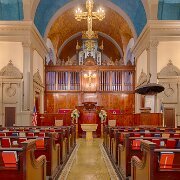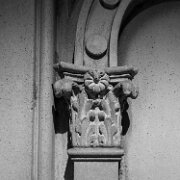
14 The St. Augustine Lighthouse holds a fascinating history that stretches back centuries. The original structure, known as the Spanish Watchtower, was built in the late 16th century to protect the city of St. Augustine, Florida, from potential attacks by enemy ships. This primitive tower served as a lookout point, providing early warning signals to the Spanish settlers. However, it was deemed inadequate due to its limited height and vulnerability to pirate raids.
In the late 19th century, the present-day St. Augustine Lighthouse was constructed to replace the aging Spanish Watchtower. Completed in 1874, the new lighthouse stood at an impressive height of 165 feet, making it one of the tallest in the United States. Its distinctive black and white spiral pattern was chosen to distinguish it from other lighthouses along the Florida coast. Over the years, the lighthouse underwent various technological upgrades, including the installation of a first-order Fresnel lens, which significantly increased its visibility. Today, the St. Augustine Lighthouse stands as a testament to the rich maritime heritage of the region and continues to attract visitors from around the world who are eager to explore its historical significance and enjoy breathtaking views from the top
In the late 19th century, the present-day St. Augustine Lighthouse was constructed to replace the aging Spanish Watchtower. Completed in 1874, the new lighthouse stood at an impressive height of 165 feet, making it one of the tallest in the United States. Its distinctive black and white spiral pattern was chosen to distinguish it from other lighthouses along the Florida coast. Over the years, the lighthouse underwent various technological upgrades, including the installation of a first-order Fresnel lens, which significantly increased its visibility. Today, the St. Augustine Lighthouse stands as a testament to the rich maritime heritage of the region and continues to attract visitors from around the world who are eager to explore its historical significance and enjoy breathtaking views from the top

15 The St. Augustine Lighthouse holds a fascinating history that stretches back centuries. The original structure, known as the Spanish Watchtower, was built in the late 16th century to protect the city of St. Augustine, Florida, from potential attacks by enemy ships. This primitive tower served as a lookout point, providing early warning signals to the Spanish settlers. However, it was deemed inadequate due to its limited height and vulnerability to pirate raids.
In the late 19th century, the present-day St. Augustine Lighthouse was constructed to replace the aging Spanish Watchtower. Completed in 1874, the new lighthouse stood at an impressive height of 165 feet, making it one of the tallest in the United States. Its distinctive black and white spiral pattern was chosen to distinguish it from other lighthouses along the Florida coast. Over the years, the lighthouse underwent various technological upgrades, including the installation of a first-order Fresnel lens, which significantly increased its visibility. Today, the St. Augustine Lighthouse stands as a testament to the rich maritime heritage of the region and continues to attract visitors from around the world who are eager to explore its historical significance and enjoy breathtaking views from the top
In the late 19th century, the present-day St. Augustine Lighthouse was constructed to replace the aging Spanish Watchtower. Completed in 1874, the new lighthouse stood at an impressive height of 165 feet, making it one of the tallest in the United States. Its distinctive black and white spiral pattern was chosen to distinguish it from other lighthouses along the Florida coast. Over the years, the lighthouse underwent various technological upgrades, including the installation of a first-order Fresnel lens, which significantly increased its visibility. Today, the St. Augustine Lighthouse stands as a testament to the rich maritime heritage of the region and continues to attract visitors from around the world who are eager to explore its historical significance and enjoy breathtaking views from the top

16 The Memorial Presbyterian Church in St. Augustine, Florida, is a magnificent structure that holds a significant place in the city's history and architectural heritage. Constructed in the late 19th century, the church was commissioned by Henry Morrison Flagler, a prominent industrialist and co-founder of Standard Oil. Flagler built the church as a memorial to his daughter, Jennie Louise, who tragically passed away due to complications from childbirth. The church's design draws inspiration from the Venetian Renaissance style, featuring ornate details and exquisite craftsmanship.
Architectural elements such as the grand entrance, intricate stained glass windows, and towering spires contribute to the church's impressive appearance. The interior is adorned with beautiful marble columns, a magnificent pipe organ, and elaborate woodwork. The Memorial Presbyterian Church stands as a testament to Flagler's devotion to his daughter and his commitment to the growth and development of St. Augustine. It remains an iconic landmark, attracting visitors who appreciate its historical significance and architectural splendor, while serving as an active place of worship for the local community.
Architectural elements such as the grand entrance, intricate stained glass windows, and towering spires contribute to the church's impressive appearance. The interior is adorned with beautiful marble columns, a magnificent pipe organ, and elaborate woodwork. The Memorial Presbyterian Church stands as a testament to Flagler's devotion to his daughter and his commitment to the growth and development of St. Augustine. It remains an iconic landmark, attracting visitors who appreciate its historical significance and architectural splendor, while serving as an active place of worship for the local community.

17 The Memorial Presbyterian Church in St. Augustine, Florida, is a magnificent structure that holds a significant place in the city's history and architectural heritage. Constructed in the late 19th century, the church was commissioned by Henry Morrison Flagler, a prominent industrialist and co-founder of Standard Oil. Flagler built the church as a memorial to his daughter, Jennie Louise, who tragically passed away due to complications from childbirth. The church's design draws inspiration from the Venetian Renaissance style, featuring ornate details and exquisite craftsmanship.
Architectural elements such as the grand entrance, intricate stained glass windows, and towering spires contribute to the church's impressive appearance. The interior is adorned with beautiful marble columns, a magnificent pipe organ, and elaborate woodwork. The Memorial Presbyterian Church stands as a testament to Flagler's devotion to his daughter and his commitment to the growth and development of St. Augustine. It remains an iconic landmark, attracting visitors who appreciate its historical significance and architectural splendor, while serving as an active place of worship for the local community.
Architectural elements such as the grand entrance, intricate stained glass windows, and towering spires contribute to the church's impressive appearance. The interior is adorned with beautiful marble columns, a magnificent pipe organ, and elaborate woodwork. The Memorial Presbyterian Church stands as a testament to Flagler's devotion to his daughter and his commitment to the growth and development of St. Augustine. It remains an iconic landmark, attracting visitors who appreciate its historical significance and architectural splendor, while serving as an active place of worship for the local community.

18 The Memorial Presbyterian Church in St. Augustine, Florida, is a magnificent structure that holds a significant place in the city's history and architectural heritage. Constructed in the late 19th century, the church was commissioned by Henry Morrison Flagler, a prominent industrialist and co-founder of Standard Oil. Flagler built the church as a memorial to his daughter, Jennie Louise, who tragically passed away due to complications from childbirth. The church's design draws inspiration from the Venetian Renaissance style, featuring ornate details and exquisite craftsmanship.
Architectural elements such as the grand entrance, intricate stained glass windows, and towering spires contribute to the church's impressive appearance. The interior is adorned with beautiful marble columns, a magnificent pipe organ, and elaborate woodwork. The Memorial Presbyterian Church stands as a testament to Flagler's devotion to his daughter and his commitment to the growth and development of St. Augustine. It remains an iconic landmark, attracting visitors who appreciate its historical significance and architectural splendor, while serving as an active place of worship for the local community.
Architectural elements such as the grand entrance, intricate stained glass windows, and towering spires contribute to the church's impressive appearance. The interior is adorned with beautiful marble columns, a magnificent pipe organ, and elaborate woodwork. The Memorial Presbyterian Church stands as a testament to Flagler's devotion to his daughter and his commitment to the growth and development of St. Augustine. It remains an iconic landmark, attracting visitors who appreciate its historical significance and architectural splendor, while serving as an active place of worship for the local community.

19 The Memorial Presbyterian Church in St. Augustine, Florida, is a magnificent structure that holds a significant place in the city's history and architectural heritage. Constructed in the late 19th century, the church was commissioned by Henry Morrison Flagler, a prominent industrialist and co-founder of Standard Oil. Flagler built the church as a memorial to his daughter, Jennie Louise, who tragically passed away due to complications from childbirth. The church's design draws inspiration from the Venetian Renaissance style, featuring ornate details and exquisite craftsmanship.
Architectural elements such as the grand entrance, intricate stained glass windows, and towering spires contribute to the church's impressive appearance. The interior is adorned with beautiful marble columns, a magnificent pipe organ, and elaborate woodwork. The Memorial Presbyterian Church stands as a testament to Flagler's devotion to his daughter and his commitment to the growth and development of St. Augustine. It remains an iconic landmark, attracting visitors who appreciate its historical significance and architectural splendor, while serving as an active place of worship for the local community.
Architectural elements such as the grand entrance, intricate stained glass windows, and towering spires contribute to the church's impressive appearance. The interior is adorned with beautiful marble columns, a magnificent pipe organ, and elaborate woodwork. The Memorial Presbyterian Church stands as a testament to Flagler's devotion to his daughter and his commitment to the growth and development of St. Augustine. It remains an iconic landmark, attracting visitors who appreciate its historical significance and architectural splendor, while serving as an active place of worship for the local community.

20 The Memorial Presbyterian Church in St. Augustine, Florida, is a magnificent structure that holds a significant place in the city's history and architectural heritage. Constructed in the late 19th century, the church was commissioned by Henry Morrison Flagler, a prominent industrialist and co-founder of Standard Oil. Flagler built the church as a memorial to his daughter, Jennie Louise, who tragically passed away due to complications from childbirth. The church's design draws inspiration from the Venetian Renaissance style, featuring ornate details and exquisite craftsmanship.
Architectural elements such as the grand entrance, intricate stained glass windows, and towering spires contribute to the church's impressive appearance. The interior is adorned with beautiful marble columns, a magnificent pipe organ, and elaborate woodwork. The Memorial Presbyterian Church stands as a testament to Flagler's devotion to his daughter and his commitment to the growth and development of St. Augustine. It remains an iconic landmark, attracting visitors who appreciate its historical significance and architectural splendor, while serving as an active place of worship for the local community.
Architectural elements such as the grand entrance, intricate stained glass windows, and towering spires contribute to the church's impressive appearance. The interior is adorned with beautiful marble columns, a magnificent pipe organ, and elaborate woodwork. The Memorial Presbyterian Church stands as a testament to Flagler's devotion to his daughter and his commitment to the growth and development of St. Augustine. It remains an iconic landmark, attracting visitors who appreciate its historical significance and architectural splendor, while serving as an active place of worship for the local community.













St. Augustine